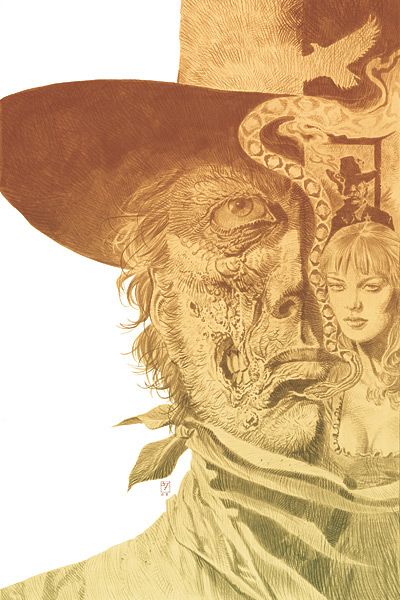Surely you know about this three-year old "Jonah Hex" series by now, and its nearly unique approach to single-issue stories. Other than the Marvel Adventures or Johnny DC lines, I can't think of another Marvel or DC comic that has so adamantly stuck to the done-in-one philosophy. Not every "Jonah Hex" story has been completely self-contained, but all but a few have, and not only are they single-issue stories, they don't use recurring subplots or characters very often, either. Almost every issue of "Jonah Hex" feels like a first issue, and that's not a bad thing. As a regular reader, I'd like to see a bit more of a link from issue to issue, but I can appreciate that Justin Gray and Jimmy Palmiotti are trying to do something different here, and when an issue like this comes along, I can certainly recommend it without reservation.
"Jonah Hex" #35 is a step above the average (if always dependably good) Jonah Hex stories. Darwyn Cooke's art received the spotlight a few issues ago in what I thought was a gorgeous, if overwritten, single issue, and here we get the sumptuous art of J. H. Williams III (as colored by Dave Stewart -- the best in the biz). Williams doesn't rely on as much heavy black in "Jonah Hex" as he has in other recent work. Instead, his feathering and crosshatching recalls the work of Moebius on the "Lt. Blueberry" comic -- a series sadly out of print these days, but a clear milestone in the western genre. Williams has a reputation for being a kind of artistic chameleon, adopting the styles of other artists for last year's "Batman" arc or "Seven Soldiers" #1, both done in collaboration with Grant Morrison. In "Jonah Hex," he's not doing his Moebius impression so much as evoking Moebius in the linework and inking. The layouts and storytelling is all his, though, and of all the mainstream artists working today, Williams is the most fearless when composing a page. It's beautiful stuff.
Gray and Palmiotti's story is an odd one, to say the least. Like many "Jonah Hex" stories, it deals with Hex trying to get paid for a job, and the complications that arise because of it. But in this case, it's not as simple as Hex outwitting the man who owes him money, because there's a girl involved, and sex, and possibly death. Unlike the Cooke story, it's not overwritten, and Williams bears most of the storytelling burden, and appropriately so.
The last eight pages of the story allow Williams to break out some of his psychedelic effects, turning this comic into two-thirds "Lt. Blueberry" and one-third "Promethea," in appearance, if not in ambition. Even though I tend to think that comic book artwork should be in the service of the story, when you're dealing with an artist as skilled as Williams, it's the art that matters. And he takes this story and makes it glow -- always remaining faithful to the narrative, but turning a fine story into something visually spectacular.
"Jonah Hex" has a six-part story coming up, and while I'm looking forward to some more developed continuity in this series, I will miss the fact that an artist like J. H. Williams III won't be able to work on something of that length. These days, he produces only a few issues a year, but I can't complain. His work here is wonderful, even if it's just for a fleeting twenty-two pages.

